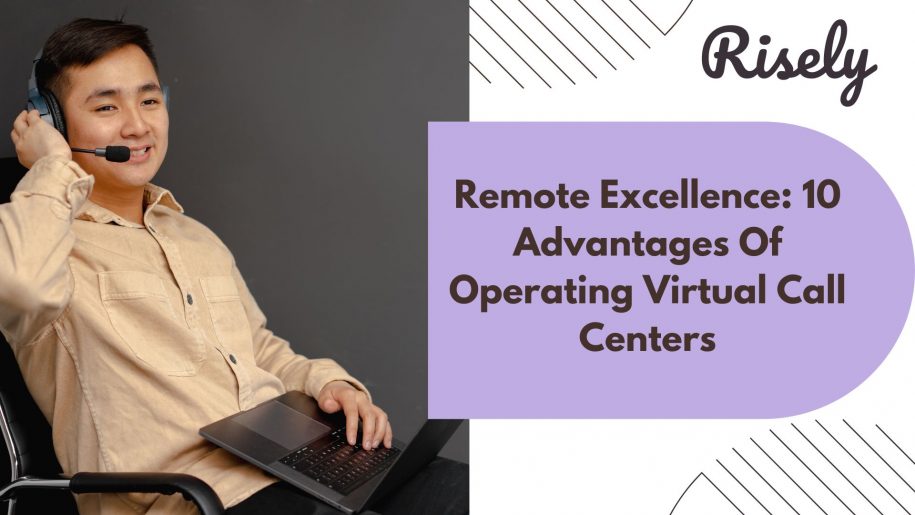Remote Excellence: 10 Advantages Of Operating Virtual Call Centers
In today’s rapidly evolving business landscape, the concept of call centers has taken a transformative leap into the virtual realm. The rise of virtual call centers is reshaping how businesses interact with their customers, revolutionizing customer service operations, and unlocking a new era of flexibility and efficiency. This blog delves into virtual call centers, exploring what they are, why businesses are embracing them, and the benefits they bring to the forefront of modern customer support strategies. Keep reading to discover how this innovative approach changes how organizations connect with their audience and elevate customer service experiences.What are virtual call centers?
Virtual call centers, also known as remote or cloud call centers, are customer service centers where customer interactions are handled by agents who work remotely from different locations rather than being physically present in a centralized office. In a virtual call center setup, agents use technology and communication tools to handle calls, chats, emails, and other customer inquiries from their homes or remote workspaces. Virtual call centers leverage internet-based communication systems, cloud-based software, and advanced collaboration tools to enable agents to access customer information, follow scripts, provide assistance, and manage interactions just as they would in a traditional call center environment. Virtual call centers offer a modern approach to customer service delivery, embracing the changing dynamics of work and technology.Advantages of virtual call centers
Virtual call centers offer a range of advantages for both organizations and employees. Some key benefits of implementing virtual call centers:- Cost savings: Virtual call centers eliminate the need for physical office space, reducing overhead costs associated with rent, utilities, and equipment. This translates to significant cost savings for organizations.
- Access to global talent: Organizations can hire agents from different locations, allowing them to tap into a diverse pool of talent with various skills, languages, and cultural backgrounds.
- Flexibility for agents: Remote work allows agents to work from their preferred location, resulting in better work-life balance and reduced commuting stress.
- Extended service hours: With agents in different time zones, call centers can provide customer support during extended hours, accommodating customers across various regions.
- Scalability: Virtual centers can easily scale up or down to meet fluctuating call volumes without the constraints of physical space limitations.
- Workforce diversity: Virtual centers promote diversity and inclusivity by enabling individuals with disabilities or caregiving responsibilities to work from home.
- Reduced turnover: Agents often experience higher job satisfaction due to the flexibility offered, leading to lower turnover rates and increased employee retention.
- Improved employee productivity: Reduced commuting time and a comfortable work environment can increase agent productivity and engagement.
- Real-time data access: Cloud-based systems enable agents to access customer data and relevant resources in real-time, enhancing the quality of interactions.
- Elevated customer experience: Well-trained agents, regardless of their location, can provide consistent, high-quality customer service, enhancing the customer experience.
Other Interesting Reads
Disadvantages of virtual call centers
While virtual call centers offer numerous advantages, they have drawbacks and challenges. Some of the potential disadvantages of implementing a virtual call center are:- Lack of direct supervision: Managers may find it challenging to directly supervise and monitor remote agents, which can lead to difficulty ensuring consistent performance and adherence to guidelines.
- Communication barriers: Remote communication can sometimes be less effective than face-to-face interactions, leading to misunderstandings, misinterpretations, and delays in resolving issues.
- Isolation and loneliness: Remote agents might experience feelings of isolation and loneliness due to the absence of in-person interactions with colleagues and supervisors.
- Technical issues: Connectivity problems, hardware malfunctions, and other technical issues can disrupt remote agents’ ability to handle calls and provide quality service.
- Security concerns: Transmitting sensitive customer data over the internet poses security risks, and organizations must ensure robust cybersecurity measures to protect customer information.
- Difficulty in team collaboration: Collaborating on projects, sharing knowledge, and brainstorming ideas can be more challenging in a remote setting, potentially impacting teamwork.
- Distractions at home: Remote agents may face distractions at home, such as family members, pets, or household chores, which can affect their focus and productivity.
- Quality control: Ensuring consistent quality assurance and performance monitoring across remote agents can be more complex than a centralized setup.
- Cultural and time zone differences: Managing agents from various geographic locations might lead to challenges related to varying cultural norms, time zones, and communication preferences.
- Limited access to resources: Remote agents might need more access to immediate support from supervisors or colleagues when encountering complex or unfamiliar situations.
Tips for effective management of virtual call centers
Managing the virtual call center comes with challenges and requires specific strategies to ensure success. Some tips for managers to effectively manage the virtual call center:- Clear communication: Establish communication channels using video conferencing, messaging apps, and regular virtual meetings to ensure that agents are well-informed and connected.
- Provide adequate training: Offer comprehensive remote training and onboarding sessions to ensure that agents have the necessary skills and knowledge to excel in their roles.
- Use technology wisely: Invest in robust cloud-based call center software, collaboration tools, and virtual training platforms to facilitate seamless remote work and performance monitoring.
- Regular feedback and coaching: Provide consistent feedback and coaching to remote agents, addressing areas for improvement and recognizing their achievements.
- Performance monitoring: Utilize real-time dashboards, analytics, and call monitoring tools to track agent performance and identify areas that need attention.
- Flexible scheduling: Allow agents to have some flexibility in setting their work hours while ensuring adequate coverage during peak call times.
- Encourage collaboration: Foster a sense of teamwork and collaboration among remote agents through virtual team-building activities, forums, and regular check-ins.
- Promote work-life balance: Emphasize the importance of work-life balance and encourage agents to take regular breaks and disconnect after work hours.
- Recognize and reward: Acknowledge and reward exceptional performance among remote agents to boost motivation and job satisfaction.
- Career development: Offer opportunities for career advancement, skill development, and growth for remote agents to keep them motivated and engaged.
Conclusion
In customer service, virtual call centers have emerged as a dynamic solution that offers businesses unprecedented opportunities for efficiency, flexibility, and global reach. As we conclude our blog on virtual call centers, it’s clear that they represent more than just a technological advancement – they signify a fundamental shift in how businesses interact with their customers. By harnessing the power of remote connectivity, diverse talent, and advanced technology, virtual call centers are not just a trend but a strategic imperative for businesses aiming to excel in customer service. As organizations embrace the virtual call center model, they position themselves at the forefront of innovation, poised to create exceptional customer experiences that resonate in an increasingly interconnected world.Gain the communication skills to effectively manage virtual call centers.
Take the free communication assessment to navigate challenging situations in virtual setup.
Frequently Asked Questions
What are the responsibilities of a virtual call center?
A virtual call center is responsible for handling customer interactions remotely. This includes addressing inquiries, providing support, resolving issues, and ensuring a positive customer experience.
What is a virtual call center?
A virtual call center is a customer service operation where agents work remotely, handling customer interactions via phone, email, chat, or other digital channels.
How do you manage a call center team effectively?
Effectively managing a call center team involves clear communication, setting performance expectations, providing regular feedback, offering comprehensive training, utilizing advanced technology, fostering teamwork, and prioritizing employee well-being.
Other Related Blogs
Performance Management Training: Empowering Managers To Manage Better
Performance Management Training: Empowering Managers To Manage Better Remember that feeling of dread when you knew performance review season was rolling around? Yeah, us, too. For many employees, performance reviews…
Grooming for Management: The Key to Building a Sustainable Leadership Pipeline
Grooming for Management: The Key to Building a Sustainable Leadership Pipeline Imagine a crucial leadership position opening up in your organization. You scramble to fill the role, internally and externally,…
Confused by L&D Metrics? Here’s How to Focus on What Matters
Confused by L&D Metrics? Here’s How to Focus on What Matters You’ve undoubtedly witnessed companies celebrating a record number of employees completing leadership training programs. Champagne toasts erupt, press releases…
Leading Beyond Lines: Dhun Chhokar’s Journey from Design to Management
Leading Beyond Lines: Dhun Chhokar’s Journey from Design to Management Remember the time when you were jittery and nervous about your career and were seeking advice from everyone? We’ve all…


